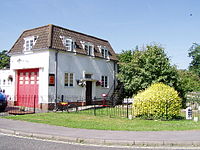West End, Hampshire
| West End | |
|---|---|
 The old West End fire station, designed by Herbert Collins |
|
| West End shown within Hampshire | |
| Population | 11,470 (2011 Census) |
| OS grid reference | SU471138 |
| Civil parish |
|
| District | |
| Shire county | |
| Region | |
| Country | England |
| Sovereign state | United Kingdom |
| Post town | SOUTHAMPTON |
| Postcode district | SO30, SO18 |
| Dialling code | 023 |
| Police | Hampshire |
| Fire | Hampshire |
| Ambulance | South Central |
| EU Parliament | South East England |
| UK Parliament | |
| Website | West End Parish Council |
West End is a parish in Hampshire, situated within the borough of Eastleigh, and to the north east of the city of Southampton. As well as the village itself, the parish contains the Chartwell Green suburb of Southampton. The village is small and generally classed as an area in the outer suburbs or rural urban fringe of Eastleigh because of the surrounding woodland and countryside, including Telegraph Woods and Itchen Valley Country Park.
The village is mainly known for being home of the Rose Bowl, the stadium where Hampshire County Cricket Club plays, and occasionally England.
West End also homes Moorgreen Hospital a classic Victorian building, rich in history, the original St James School, built in 1901, on the high street, and West End Fire Station, which nowadays is a museum in the centre of the village.
A series of round barrows, dating from the Bronze Age (2000-600 BC), have been discovered in the Moorgreen area of the parish. There were five of these, all situated behind (i.e. to the north of) the former Moorgreen Hospital site. A hilltop fort from the Iron Age was built on the ridge above the village around 600-100BC. A shutter telegraph station operated from the site during the Napoleonic Wars, forming part of the line connecting London to Plymouth. It was this station that gave the name to the nearby Telegraph Woods.
The village was originally a hamlet which grew up around a track between Romsey and Portsmouth. The hamlet had a chapel by 1552 primarily for the use of the lords of the manor of Allington. When the track became a turnpike road in the early 19th century, the hamlet began to grow.
...
Wikipedia

